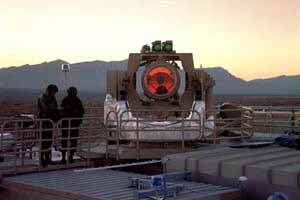U.S.-Israel Strategic Cooperation: Tactical High Energy Laser Program
(Updated January 2006)
In 1995, the United States and Israel greenlighted the Tactical High Energy Laser (THEL) program. The THEL was designed as a transportable laser weapon system used to counter short-range rockets that was planned for use by both the Israel Defense Forces and the U.S. Army. The U.S. Army Space & Strategic Defense Command together with the Israel Ministry of Defense managed the program which conducted tests at the in New Mexico.
 |
The THEL precursor, the Nautilus, destroyed a short-range rocket in flight during testing in February 1996 at a site in New Mexico, nine months after the project was launched. This was the first time a laser has ever destroyed a ballistic missile.
In April 1996, the U.S. agreed to accelerate high energy laser development after Hezbollah guerrillas fired over two dozen of Katyusha rockets at Israel in a two-week period. President Clinton and U.S. Defense Secretary William Perry pledged to expand work on the THE and in July 1996 an $89 million contract was signed to design, build, integrate and test the THEL.
In January 1998, another $42.5 million contract was alloted for field tests of the THEL against Katyushas at the U.S. Army's High Energy Laser Test Facility at White Sands Missile Range, New Mexico.
In May 1999, the THEL program ran into problems when the U.S. contractor for the weapons system abandoned the project because of disagreements with the U.S. Army and Israeli government over who is responsible for paying for cost-overruns. A new contract was agreed upon.
On June 7, 2000, the THEL successfully shot down a rocket for the first time in a test at the White Sands Missile Range in New Mexico.
"The success of the test is a crucial step in building a solution to deal with the Katyusha threat on the northern border, even though there is a long road ahead of us," said Maj.-Gen. Yitzhak Ben-Yisrael, director of development of weapons systems and infrastructure at the Israel Defense Ministry.
In January 2006, after years of setbacks and above-budget costs, the Pentagon announced cancellation of the THEL program. Israel, disappointed with the announcement, called it a missed opportunity to help Israel better protect its citizens. According to Maj.-Gen. (res.) Prof. Yitzhak Ben-Yisrael, Israelis would have to “live with Kassam rockets for decades” because of the program's cancellation.
The $250 million THEL system was discovered to be too large to carry on trucks, making it almost impossible to be effective.
Years later, Israel would develop the Iron Dome Defense System with funding help from the United States.
Sources: American Israel Public Affairs Committee (AIPAC); InsideDefense; Inside the Pentagon (May 27, 1999); Jerusalem Post; Globes (January 18, 2006). Photo courtesy of TRW Inc.


